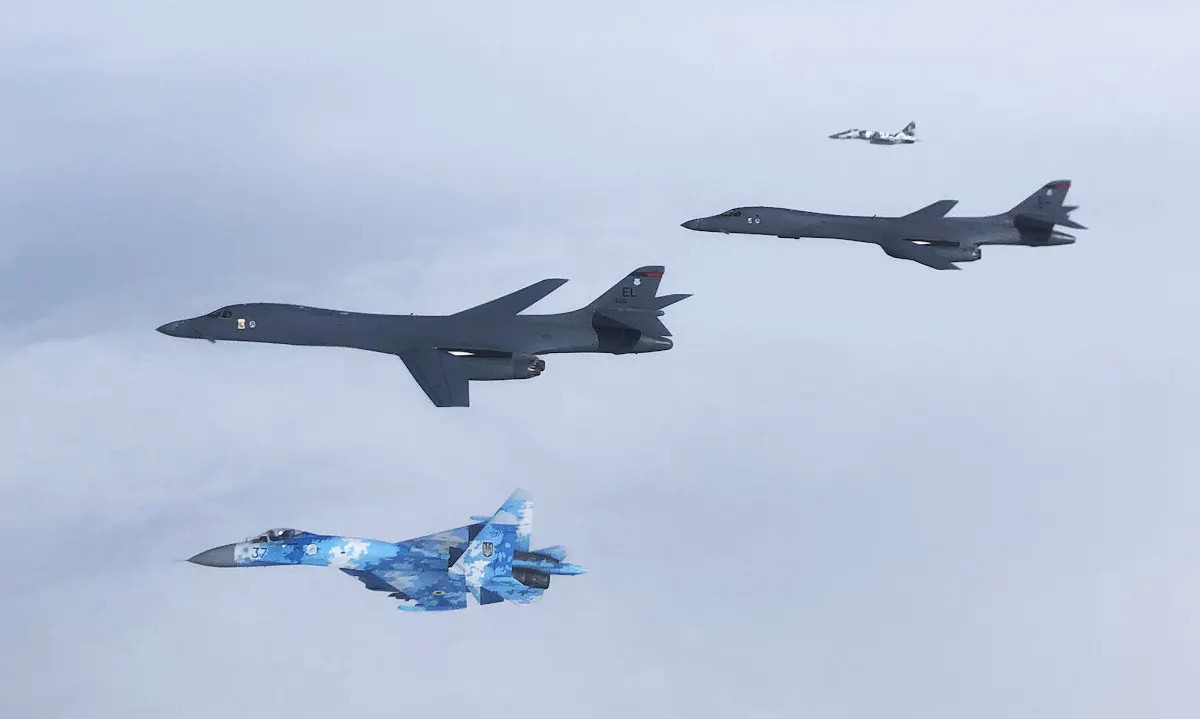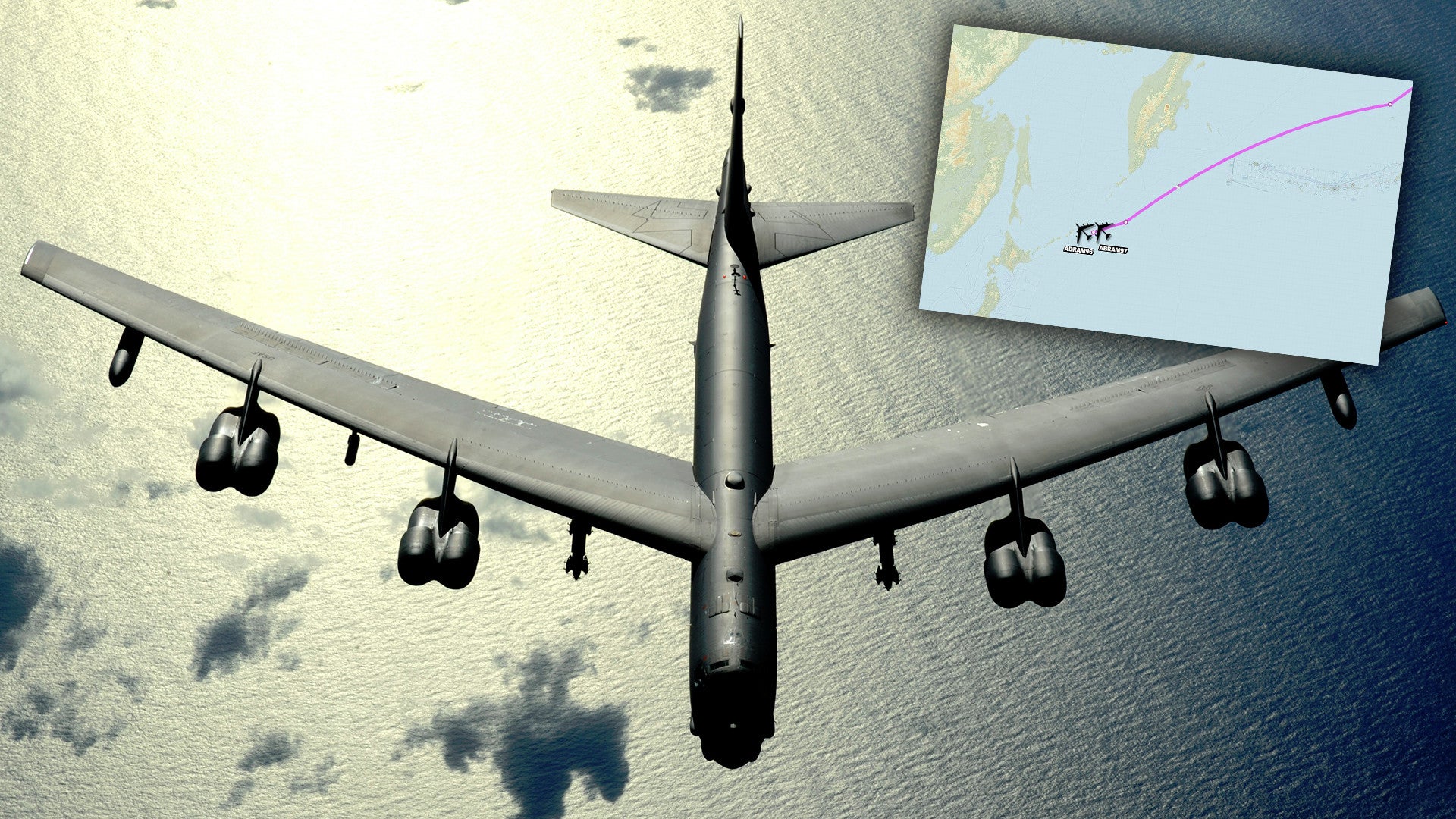The Russian military sent Su-30 Flanker and Su-35 Flanker-E fighter jets and MiG-31 Foxhound interceptors to monitor two U.S. Air Force B-52H bombers that flew over the Sea of Okhotsk yesterday. This the first time B-52Hs have flown into this body water, which is surrounded on three sides by Russian territory and where American combat aircraft typically have not ventured in the past, in recent memory. This flight also comes nearly a month after a B-1B conducted a long-range training mission along a similar route as part of the implementation of a new concept of operations for U.S. heavy bomber sorties earlier this year.
The Russian Defense Ministry’s National Defense Control Center publicly announced the intercept over the Sea of Okhotsk on June 19, 2020, though it had taken place the day before. Twitter user and good friend of The War Zone
@AircraftSpots tracked the two B-52Hs on June 18 as they flew from Eielson Air Force Base in Alaska through the Bering Sea and out over the North Pacific.
Eielson is notably not a bomber base. A trio of B-52Hs from Barksdale Air Force Base in Louisiana, which is home to the active component 2nd Bomb Wing and the Air Force Reserve 307th Bomb Wing, arrived at the base in Alaska on June 14, as part of a short-term Bomber Task Force deployment. As such, this particular flight not only underscored the ability of the bombers to project power far away from America’s borders while operating from bases within the country, it also highlighted how they can first stage themselves at other bases closer to the intended area of operation, as needed.
After arriving in the North Pacific for this particular training mission yesterday, the two B-52Hs then alerted air traffic controllers in the region that they would be flying “due regard,” or with their transponders off, for approximately two hours, at which time they turned north toward the Sea of Okhotsk. This sea is a sort of giant bay situated between Sakhalin Island to the west, as well as portions of Russia’s mainland Far East region to the north, and the Kamchatka Peninsula to the east.
“On June 19, 2020, the air defense quick reaction alert forces of the Eastern Military District spotted and started tracking a pair of US Air Force B-52H bombers over the Sea of Okhotsk,” Russia’s National Defense Control Center’s statement said. “At a considerable distance from the state border of the Russian Federation, the U.S. Air Force planes were continuously tracked by Russian monitoring capabilities. Su-30, Su-35, and MiG-31 fighters from the air defense quick reaction alert forces of the Eastern Military District were scrambled to intercept the targets.”
The statement also said that the B-52Hs did not ever appear to make a concerted approach toward Russia’s sovereign airspace and remained at least 186 miles from the country’s borders throughout the duration of the flight. “The Russian aircraft performed the flights in strict compliance with the international rules of using the airspace over the neutral waters, without violating the borders of other states,” the National Defense Control Center added.

It’s worth noting that B-52Hs, as well as B-1Bs and B-2s, have flown a near-constant, if irregularly scheduled long-range training missions across the Pacific region, as well as in and around Europe, since the Air Force adopted the Dynamic Force Employment model for bomber operations in April. This followed the abrupt decision to end the Continuous Bomber Presence mission that same month, which The War Zone
Under the Continuous Bomber Presence concept, which the service implemented 2004, new rotations of bombers deployed to the island of Guam in the Pacific roughly every six months. The goal of the Dynamic Force Employment concept, which the U.S. military as a whole has been increasingly employing, is to make it more difficult for potential adversaries to predict and monitor deployments, adding more uncertainty and risk into their operational planning processes.
However, much of the new bomber activity that has been observed in recent months has clearly been meant to send especially strong signals to potential American adversaries, especially Russia and China. In May, the Air Force released pictures of personnel on Guam loading stealthy AGM-158 Joint Air-to-Surface Standoff Missile (JASSM) land-attack cruise missiles onto a B-1B bomber in a pointed message aimed at China. That same month, other B-1Bs flew into the Black Sea on a training mission simulating the employment of AGM-158C Long-Range Anti-Ship Missiles (LRASM) in that region, where the only real possible opponent is Russia. Just this week, B-2 bombers also flew into the Norwegian Sea above the Arctic Circle, as well, the latest in a string of bomber flights over and around Northern Europe and Scandanavia in recent months.

The B-52Hs flying into the Sea of Okhotsk, very much Russia’s backyard in the Pacific, is another clear signal. The flight of a B-1B into the body of water on May 21, the first known instance of an American bomber entering the area following the adoption of the Dynamic Force Employment concept, was already a bold and largely unprecedented sortie.
These long-range training flights into the Sea of Okhotsk also come amid equally steady Russian bomber and long-range maritime patrol aircraft sorties in international airspace near Alaska. So far this year, U.S. and Canadian military aircraft assigned to the North American Aerospace Defense Command (NORAD) have intercepted Russian Tu-95 Bear bombers and Tu-142 Bear-F patrol planes, sometimes flying with other supporting aircraft, off Alaska on at least eight occasions. In March, NORAD also sent jets to intercept a pair of Tu-142s that flew relatively low over a base camp on an ice floe in international waters in the Arctic off Alaska that was supporting a U.S. Navy-led submarine exercise.

With bombers now flying long-range training missions under the Dynamic Force Employment model on a regular basis, sorties into the Sea of Okhotsk may well become an increasingly common sight, especially if Russia continues with its own more routine flights near Alaska.
Update: 1:00 PM EST—
Pacific Air Forces (PACAF) has now released pictures of the B-52s flying on their Bomber Task Force mission on June 18 together with a pair of U.S. Navy EA-18G Growler electronic warfare aircraft near the Kuril Islands, south of the Sea of Okhotsk. The Growlers could support the bombers during an actual conflict or other contingency in the region. A U.S. Marine Corps EA-6B Prowler electronic warfare aircraft, a type that the Navy also operated until it replaced them with the EA-18G, notably provided similar support for the U.S.-led missile barrage against targets in Syria in 2018. B-1B bombers also took part in that operation, among other aircraft and naval assets.
The Kuril Islands are notably at the center of a long-standing dispute between Russia and Japan, the latter of which is a U.S. ally. The Russian government presently administers all of the 56 islands in the chain, but Japanese authorities claim that the four southernmost ones are their sovereign territory. This disagreement on the final status of these islands has prevented the two countries from ever signing a formal World War II peace deal, despite that conflict having been over for 75 years.
Contact the author: joe@thedrive.com
